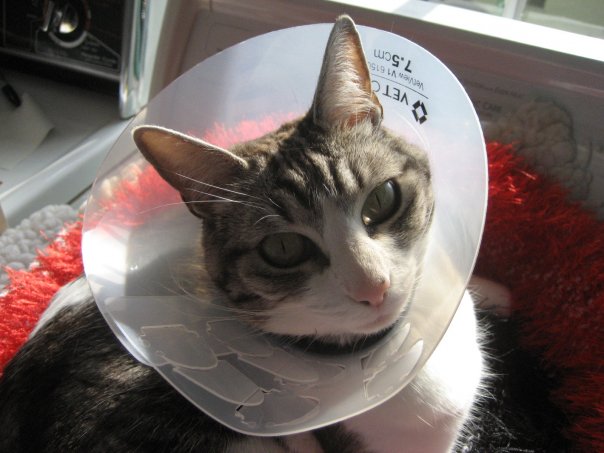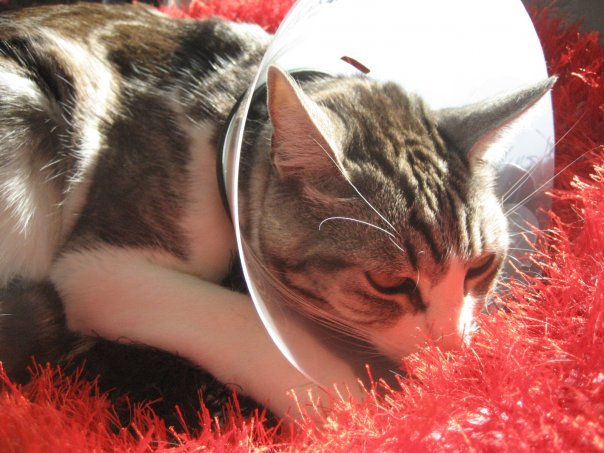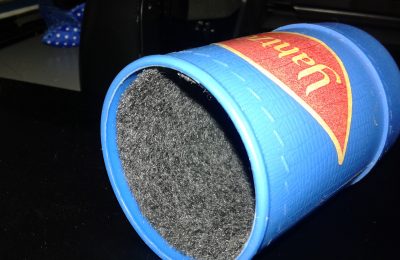Has your cat or dog ever had to wear a “cone of shame”? Also known as an Elizabethan collar (or an E-collar), and resembling more of a lampshade, these devices are routinely prescribed by veterinarians to prevent our pets from scratching themselves, biting at sutures, or otherwise harming themselves.
Apparently the term “cone of shame” was popularized by the movie “Up” – perhaps referring to the fact that it likely feels like a punishment to the wearer. It’s no walk in the park for the pet owner either – turns out that owners are reluctant to use them on their pets, and do not use them for the full length of time recommended by their vet. Cones may even be dangerous, with at least two dogs dying due to getting tangled in plastic bags while wearing the collar.
A recent open-access study (“The Cone of Shame”: Welfare Implications of Elizabethan Collar Use on Dogs and Cats as Reported by their Owners) surveyed pet owners with cats or dogs who had needed an E-collar in the last year, asking several questions about why the collar had been recommended, how long the pet had to wear the collar, and whether the owner had observed problems or signs of stress in their pet. There were 434 participants who reported that their pet had a wear the collar for anywhere from 3-7 days.
More than half of owners reported welfare concerns related to the use of the collar: 60.2% said the collar interfered with drinking, and 67.5% reported that their pet was unable to play while wearing the collar. A quarter of pets experienced (mostly minor) injuries from wearing the collar such as itching, trauma, or bumping into walls or objects. Almost of quarter of animals were able to remove the collar on their own, but their owners were helping them out too: over half of owners just took the collar off their pet when they were supervising them.

The majority of owners reported that their pet had a worse quality of life while wearing the cone, and reported that their pet was “depressed”, had difficulties eating, and that the distress was worse than the behavior it was supposed to prevent. In some cases, the cone didn’t fit well, and some animals could not jump or walk normally when wearing them.
On the plus side, owners did feel that the cone of shame was effective at preventing the behavioral responses such as licking or biting. It is possible that some cats and dogs could be trained to habituate to and accept wearing a collar, but that is not the approach that most owners can take – the collar needs to go on NOW, not after the pet has been sensitized to it.
I had my own experience a few years ago with the cone and my cat. She was limping, so we took her to the emergency vet. She was diagnosed with “lameness” (okay, it still makes me chuckle) – just a soft tissue injury — and sent home with pain killers and a cone. Why the cone? I still don’t know. She hated it, and like many pet owners, we did not comply, and we took it off her after just a few hours of her misery. She recovered just fine.

So is the cone of shame a necessary evil? Is it necessary at all? Are there other options? I decided to throw some questions at one of my favorite experts when it comes to medical care for cats, Ellen Carozza, LVT, who works at the Nova Cat Clinic in the DC area. She has specialized in feline medicine for almost two decades, and trust me, this woman knows her sh*t. But I also knew from previous conversations with her that she shared some of my concerns about the routine use of the cone of shame.
***************
Why did your clinic stop the routine use of e-collars?
EC: We noticed it caused more stress to the patient when they wear them. When a patient is properly pain managed using a multimodal method, we have found they will not pick or groom the suture area. We barely have external sutures – we do internal and subcutaneous or subcuticular to minimize the picking as well.
The main complaints we get from clients on e-collars is that the cats won’t eat, they bonk into the walls, become depressed and overly groom the e-collar (that is a indication of pain…they just can’t get to the spot but trying to groom it sure does help!). These cats may also not rest well due to the collar propping their head and face up, so that adds to the discomfort and now the animal can’t get comfortable and sleep. And sleep and rest is very important with the healing process.
Using a local block, opiates, Gabapentin and NSAIDS (if the kidneys will allow it) along with complimentary therapies such as laser and the Assisi Loop aid in healing because the pet is kept comfortable and the acute and chronic pain is diminished and kept to a minimum.
Why do most veterinary clinics continue to rely on the “cone of shame”?
EC: They believe they really do help. What we should be focusing on is pain management to prevent them from wanting to pick at the first place. It is also taught that this is the standard of medicine: just stop the behavior. You also have the ” We’ve always done it *insert excuse of the day here.*
You can’t always trust the owners to keep the area clean and dry. Most clients don’t even check incision sites daily. So putting a collar on the animal prevents the client from having to do an extra job as a pet parent and pay attention.
What are the alternatives? Is it time to end this “shameful” practice?
EC: There are lots of alternatives. Some of the newer “cloud or balloon collars” allow the animal to eat more freely, but don’t allow the head to rest properly either as it’s an inflatable ring. The “No Bite” collars are neck braces that prevent the neck from bending back to function normally. Some companies go as far as making ridiculous, yet cute e-collars that resemble flowers or lion manes so something so “shameful” isn’t (clever marketing). OR the best thing ever is to PROPERLY PAIN MANAGE!!! and address any underlying obsessive behaviors with mood modifying drugs and environmental changes (especially the cats who just clean obsessively and you can’t find the reason why medically).
Do I think it’s time to end the “shameful” practice? I think it’s time for better pain management, behavior and environmental modifications to be done to limit the routine use of them in practice. Understanding the feline pain body scoring allows you to stay ahead of the issue at hand and not have to rely on a cone to suddenly halt a behavior.
******************
Hopefully this research will help increase awareness that e-collars are not necessarily necessary or helpful to maintaining companion animal welfare while helping them heal. People hate ‘em, our pets hate ‘em, it’s time to start taking the alternatives seriously!
References
Shenoda, Y., Ward, M. P., McKeegan, D., & Fawcett, A. (2020). “The Cone of Shame”: Welfare Implications of Elizabethan Collar Use on Dogs and Cats as Reported by their Owners. Animals, 10(2), 333.
Shumaker, A. K. (2019). Diagnosis and treatment of canine acral lick dermatitis. Veterinary Clinics: Small Animal Practice, 49(1), 105-123.
Wilson, S. (1993). Elizabethan collars and plastic bags. The Veterinary record, 132(26), 664-664.



